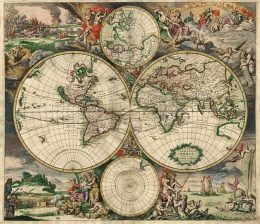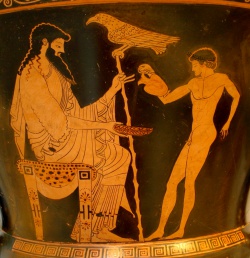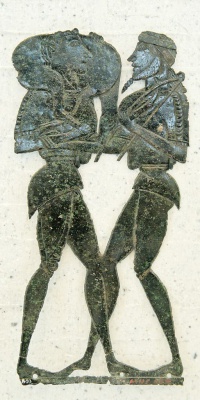Boylove in antiquity
| Part of the boylove history series |
 |
| Portal:History |
In antiquity, boylove was seen as an educational institution for teaching moral and cultural values in some cultures,[1][2] as well as a form of sexual expression, entered history from the Archaic period onwards in Ancient Greece, though Cretan ritual objects reflecting an already formalized practice date to the late Minoan civilization, around 1650 BC.[3] According to Plato, who was not a boylover and not the best source,[4] in ancient Greece, boylove was a relationship and bond – whether sexual or chaste – between an adolescent boy and an adult man outside of his immediate family. While most Greek men engaged in relations with both women and boys,[5] exceptions to the rule were known, some avoiding relations with women, and others rejecting relations with boys. In Rome, relations with boys took a more informal and less civic path, men of dominant social status attracting young lovers who were social inferiors seeking to advance their position, or carrying on illicit relationships with freeborn boys.[6]
Analogous relations were documented among other ancient peoples, such as the Thracians,[7] and the Celts. According to Plutarch, the ancient Persians, too, had long practiced it, an opinion seconded by Sextus Empiricus who asserted that the laws of the Persians "recommended" the practice.[8] Herodotus, however, asserts they learned copulation with boys (παισὶ μίσγονται) from the Greeks,[9] by the use of that term reducing their practice to what John Addington Symonds describes as the "vicious form" of pederasty,[10] as opposed to the more restrained and cultured one valued by the Greeks. Plutarch, however, counters Herodotus by pointing out that the Persians had adored eunuch boys long before being exposed to the mores of the Greeks.[11]
The Greeks

Zeus and Ganymede
- Main articles: Ancient Greece
Plato was an early critic of sexual intercourse in pederastic relationships, proposing that men's love of boys avoid all carnal expression and instead progress from admiration of the lover's specific virtues to love of virtue itself in abstract form. While copulation with boys was often criticized and seen as shameful and brutish,[12] other aspects of the relationship were considered beneficial, as indicated in proverbs such as A lover is the best friend a boy will ever have.[13]
The pederastic relationship had to be approved by the boy's father. Boys entered into such relationships in their teens, around the same age that Greek girls were given in marriage. The mentor was expected to teach the young man or to see to his education, and to give him certain appropriate ceremonial gifts.
The physical dimension ranged from fully chaste to sexual intercourse. Pederastic art shows seduction scenes as well as sexual relations. In the seduction scenes the man is standing, grasping the boy's chin with one hand and reaching to fondle his genitals with the other. In the sexual scenes, the partners stand embracing face to face, the older of the two engaged in intercrural sex with the younger, who (usually but not always) does not show arousal. Anal sex is almost never shown, and then only as something eliciting surprise in the observers. The practice was ostensibly disparaged, the Athenians often naming it jocularly after their Dorian neighbors ("cretanize," "laconize," "chalcidize"). While revisionist historians such as Dover and Halperin hold that only the man experienced pleasure, art and poetry indicating no reciprocation of desire, other historians assert that it is "a modern fairy tale to say that the younger eromenos was never aroused."[14]
Pederastic couples were also said to be feared by tyrants, because the bond between the friends was stronger than that of obedience to a tyrannical ruler. Plutarch gives as examples the Athenians Harmodius and Aristogeiton. Others, such as Aristotle, claimed that the Cretan lawgivers encouraged pederasty as a means of population control, by directing love and sexual desire into relations with males.[15]
Ancient Crete

- Main articles: Ancient Crete
Cretan boylove was an archaic form of pederasty[16] that involved the ritual kidnapping (harpagmos) of a noble boy by an adult male of the aristocratic class, with the consent of the boy's father.
The man (known as philetor, "befriender") took the boy (known as kleinos, "glorious") into the wilderness, where they spent several months hunting and feasting with their friends. If the boy was satisfied with the conduct of his would-be comrade, he changed his title from kleinos to parastates ("sidekick," indicating he had fought in battle alongside his lover)[17] returned to the philetor and lived in close bonds of public intimacy with him.[18]
The function of the institution, beside teaching the youth adult skills, was supposed to confirm the status of the best men, and to offer both lover and beloved the chance to give proof of a noble character deserving of respect.[19]
The Romans
- Main articles: Ancient Rome
From the early Republican times of Ancient Rome, it was perfectly normal for a man to desire and pursue boys.[20] However, penetration was illegal for free born youths; the only boys who were legally allowed to perform as a passive sexual partner were slaves or former slaves known as "freedmen", and then only with regard to their former masters. For slaves there was no protection under the law even against rape.[21]
The result was that in Roman times, pederasty largely lost its function as a ritual part of education and was instead seen as an activity primarily driven by one's sexual desires and competing with desire for women. The social acceptance of pederastic relations waxed and waned during the centuries. Conservative thinkers condemned it — along with other forms of indulgence. Tacitus attacks the Greek customs of "gymnasia et otia et turpes amores" (palaestrae, idleness, and shameful loves).[22] The emperors, however, indulged in male love — most of it of a pederastic nature — almost to a man.
Other writers spent no effort censuring pederasty per se, but praised or blamed its various aspects. Martial appears to have favored it, going as far as to essentialize not the sexual use of the catamite but his nature as a boy: upon being discovered by his wife "inside a boy" and offered the "same thing" by her, he retorts with a list of mythological personages who, despite being married, took young male lovers, and concludes by rejecting her offer since "a woman merely has two vaginas."[23]
Other civilizations
Boylove in ancient times was not the exclusive domain of the Greeks and Romans. Athenaeus in the Deipnosophists states that the Celts also partook and despite the beauty of their women, preferred the love of boys. Some would regularly bed down on their animal skins with a lover on each side. Other writers also attest to Celtic boylove: Aristotle (Politics, II 6.6. Athen. XIII 603a.), Strabo (iv. 199), and Diodorus Siculus (v. 32)). Some moderns have interpreted Athenaeus as meaning that the Celts had a boy on each side, but that interpretation is questioned by Hubbard, who reads it as meaning that they had a boy one side and a woman on the other. (Hubbard, 2003; p. 79)
Persian boylove and its origins was debated even in ancient times. Herodotus claimed they had learned it from the Greeks: "From the Greeks they have learned to lie with boys."[24] However, Plutarch asserts that the Persians used eunuch boys to that end long before contact between the cultures.[25] In either case, Plato claimed they saw fit to deny boylove to the inhabitants of the lands they occupied, since "It does not suit the rulers that their subjects should think noble thoughts, nor that they should form the strong friendships and attachments which these activities, and in particular love, tend to produce."[26]
Boylove was also prominent in Pre-Columbian era America among the Mayans, Kodiak, and other native American groups.
See also
References
- ↑ Article adapted from Wikipedia
- ↑ Freeman, Charles (1999). The Greek Achievement: The Foundation of the Western World. Allen Lane. pp. 299–300. ISBN 0-7139-9224-7.
- ↑ Bruce L. Gerig, "Homosexuality in the Ancient Near East, beyond Egypt", in HOMOSEXUALITY AND THE BIBLE, Supplement 11A, 2005
- ↑ Plato, Phaedrus; passim
- ↑ J.K. Dover, Greek Homosexuality; passim
- ↑ Crompton, op.cit., pp.79-82
- ↑ Ovid, Metamorphoses, 10.67-85
- ↑ Jeremy Bentham, Offences Against One's Self Journal of Homosexuality, v.3:4(1978), p.389-405; continued in v.4:1(1978)
- ↑ Herodotus, Histories, I.135
- ↑ J. A. Symonds, A Problem in Greek Ethics; V.
- ↑ Plutarch, On the Malice of Herodotus;13
- ↑ Aeschines, "Against Timarchos" 127
- ↑ Plato, Phaedrus, 231
- ↑ Greek homosexuality, Hein van Dolen
- ↑ Aristotle, Politics 2.1272a 22-24 "and the lawgiver has devised many wise measures to secure the benefit of moderation at table, and the segregation of the women in order that they may not bear many children, for which purpose he instituted association with the male sex."
- ↑ Ephorus of Cyme in Strabo's Geography 10.21.4
- ↑ Wilhelm Kroll "Knabenliebe" in Pauly-Wissowa, Realencyclopaedie der klassischen Altertumswissenschaft, vol. 11, cols. 897-906 [1]
- ↑ John Addington Symonds, A Problem in Greek Ethics, X p.14
- ↑ D. B. Dodd, '"Athenian Ideas about Cretan Pederasty," in T. Hubbard (ed.), Greek Love Reconsidered, New York, 2000; pp.33-41
- ↑ Craig A. Williams, Roman Homosexuality p.23
- ↑ Prioreschi, Plinio (1996). A History of Medicine. Horatius Press. pp. p21–23, p29. ISBN 1-888456-03-5.
- ↑ Tacitus, Annales, 14.20
- ↑ Martial, Epigrams, XI.43
- ↑ Herodotus, Histories, I.135, tr. David Grene; p.97
- ↑ Plutarch, De Malig. Herod. xiii.ll
- ↑ Plato, Symposium, 182c, trans. Tom Griffith
